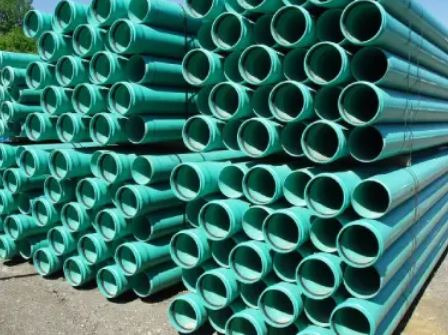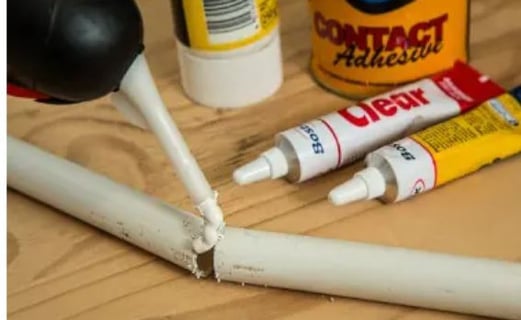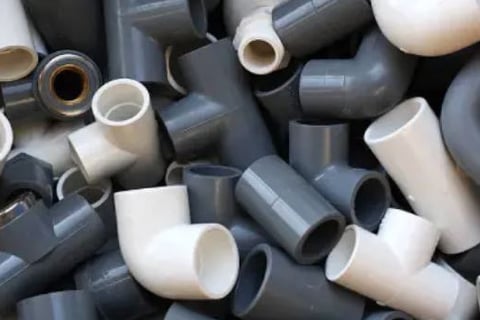Plumbing Materials: Component used in the Installation and Maintenance of Plumbing System
Plumbing materials are a wide range of fittings and fixtures. People use them to install, maintain, and repair plumbing systems. These materials include pipes, fittings, and fixtures. They also have valves, sealants, insulation, supports, hangers, and special tools. Each material serves a specific purpose in a plumbing system.
Geubko Enterprises
5/29/202411 min read


Type of plumbing materials
1. Pipes
Pipes are conduits. They pass fluids, like liquids or gases, from one place to another. Plumbers use them for many purposes. These include water supply, drainage, waste removal, and venting. Here are some kinds of pipes in plumbing.
Copper pipes
PVC pipes (Polyvinyl Chloride)
PEX (Cross-linked Polyethylene)
Galvanized steel pipes
I. Copper pipes.
Copper pipes are a type of plumbing material made from copper metal. Plumbers use them in homes and businesses. They carry both hot and cold water. Copper pipes offer several advantages, including durability, corrosion resistance, and the ability to withstand high water pressure.
Durability: Copper pipes are durable when well supported. They can last for 30 years or more, and continuing support can help guarantee durability.
Rust Resistance: Copper pipe resists rust. This makes it last long in plumbing. It forms a protective layer over time. They call it patina. Patina helps prevent decay—the patina acts as a barrier. You can separate copper material from the environment.
Heat Resistance: Copper has excellent thermal conductivity, which can transfer heat. This property makes copper pipes ideal for plumbing systems. They're used where hot water circulates, such as in homes and businesses. Copper pipes can withstand high temperatures without melting. They're for both hot and cold water.
Flexibility: Copper pipes are flexible. They are more adaptable than rigid materials like steel or iron pipes but less flexible than plastic piping materials. Examples include PVC (polyvinyl chloride) and PEX (cross-linked polyethylene). These pipes can bend a bit without breaking, which helps navigate obstacles during installation.
Bacteria Resistance: Copper pipes destroy microorganisms, so they are resistant to the growth of bacteria. This helps support water quality by preventing bacteria from growing inside the pipes.
Copper pipes come in different types and sizes, including rigid pipes and flexible tubing. They're joined using soldered or brazed fittings, creating watertight connections.
ii. PVC pipes.
People use PVC pipes in drainage, waste, and vent systems. It's a type of plastic pipe used in plumbing. These pipes are durable and cost-effective for various applications. Here are some characteristics of PVC pipes.
Durability: PVC pipes last a long time because they are durable. It can't deteriorate. They resist biological growth, rust, and chemical damage. This makes them suitable for use above or below ground.
Lightweight: PVC pipes are light. They are lighter than metal pipes, such as copper or steel. This makes them easier to handle and install. It reduces the need for heavy machinery and lowers labor costs.
Cost efficiency: PVC pipes are cheap. They're a good choice for plumbing projects on a budget.
Smooth Interior: PVC pipes have smooth interiors. They allow the flow of water, are easy to clean, and are less prone to scaling.
Insulation Properties: PVC pipes have thermal insulation properties. These properties help prevent distillation from forming on the outside of the pipe, which carries cold water.
Variety of Sizes and Types: PVC pipes are available in various sizes and thicknesses. You can find them in both rigid and flexible forms. It's allowed for installation versatility.
Ease of Installation: PVC pipes are lightweight, flexible, and simple to join. They can be cut, joined, and installed using solvent cement or threaded fittings.
PVC pipes have benefits. Yet, they can become fragile if exposed to sunlight or extreme temperatures. These pipes may not be advisable for transporting hot water above certain temperatures. They may also soften and deform under high heat.
iii. PEX pipes.
People used PEX pipes, also known as polyethylene pipes, for water supply. These distribute both hot and cold water. PEX pipes are made from high-density polyethylene polymer, which is cross-linked through either a chemical or physical process.
This cross-linking enhances the strength and durability of the material. Here are some key features and characteristics of PEX pipes:
Flexibility: PEX pipes are more flexible than copper and PVC pipes. You can bend and shape PEX pipes without fittings or connectors, making them easier to install in tight spaces and around obstacles.
Corrosion Resistance: PEX pipes are resistant to corrosion. It's helpful in maintaining water quality. This prolongs the lifespan of the plumbing system.
Freeze Resistance: PEX pipes have excellent freeze-resistance properties. They can expand without cracking when water freezes inside them. This makes them suitable for use in cold climates and for outdoor applications.
Quiet Operation: PEX pipes are quieter than metal pipes when water flows through them. It reduces the occurrence of water noise-related issues.
Cost-Effectiveness: PEX pipes are often more affordable than copper pipes. Their flexible nature can reduce labor costs associated with installation.
Longevity: PEX pipes have a long service life. They are resistant to degradation from UV exposure and environmental factors.
You can install them using crimp, clamp, or push-fit fittings. It creates secure connections without the need for soldering or glue. They're used in homes and businesses for water pipes. These are also used for radiant floor heating and snow melting.
iv. Galvanized steel pipes.
A zinc sheet protects this steel pipe to prevent corrosion. It's put in a bath of molten zinc to form a double bond connection between the zinc and the steel substrate. Here are some key features and characteristics of galvanized steel pipes:
Corrosion resistance: Experts recommend using galvanized steel pipes. They're used for outdoor buildings, water distribution, and plumbing. These have good corrosion resistance.
Durability: Galvanized steel pipes are strong and long-lasting. It can survive high temperatures and harsh environmental conditions.
Longevity: Galvanized steel pipes last a long time. Yet, only if someone maintains them well. It's usually 40 to 50 years or longer.
Strong and rigid: Galvanized steel pipes are solid and inflexible. They're ideal for use in construction and plumbing.
Accessible to Work With Galvanized steel pipes, they are easy to work with. You can cut, thread, and weld it to meet specific project requirements.
Cost-effectiveness: Galvanized steel pipes are cost-effective. They are cheaper than alternatives like copper or stainless steel, making them a cost-effective choice for various applications.
Versatility: These pipes are all-round. You can use them for many purposes, both inside and outside. It includes drainage, fences, handrails, and scaffolding.
Galvanized steel pipes are solid and adaptable. They are ideal for many purposes. You must also know its maintenance requirements.
2. Fittings
Fittings are plumbing materials used in piping systems. They connect pipes and regulate the flow of water or gas. They come in various shapes and sizes and ensure that the piping system works well. Here are some common types of fittings.
Couplings: Couplings provide a straight connection between two pipes with the same diameter. Depending on the use, they can be either rigid or flexible.
Adapters: Adapters are fittings used to connect pipes or tubes. They are of different diameters or materials, and the openings on each end are of different sizes. These adapters connect the two pipes.
Elbow: Elbows allow pipes to change direction. They're used to navigate around corners in a plumbing system.
Tees: Tees are T-shaped fittings. Its shape allows it to join two pipes into one line or to split into two distinct branches.
Reducers: Users use reducers to connect pipes of different sizes.
Cap and plugs: These come in various sizes. and are suitable for different types of pipes, fittings, and fixtures. They include plastic, rubber, or metal.
Valves: Valves are fittings used to control the flow of water. They can be open, close, or regulate the flow of water, gas, or other liquids.
Union: A union is a type of pipe fitting. They provide a detachable connection between two pipes or between a pipe and a fixture. It's done without the need for cutting or threading.
Flange: A flange is a pipe fitting. It enables connecting it to another pipe, fitting, valve, or equipment. They're circular and have bolt holes around the perimeter. It's easy to attach using bolts or screws.
Crosses: Crosses refer to a type of pipe fitting with openings on all four ends. Using them, four pipes can connect at right angles to each other. Plumbers use them in plumbing systems where pipes need to intersect or cross each other. This includes complex pipes and places where many branches connect to a main line.
3. Fixtures
In plumbing, fixtures are devices that connect to a plumbing system and provide a specific function related to water or waste management. These fixtures are installed permanently and are an essential component of both residential and commercial plumbing systems. Here are some common types of fixtures found in plumbing.
Sinks: Sinks are fixtures used for washing hands, dishes, and other items. They consist of a basin, faucet, and drain assembly.
Faucet: Faucets control water flow from pipes to sinks, showers, and other fixtures. They come in single-handle, double-handle, and touchless types. It's also available in different shapes and designs.
Bathtubs: Bathtubs are fixtures used for bathing and relaxing. They're available in different shapes and sizes, including standard alcove tubs, freestanding tubs, and whirlpool tubs.
Showers: Showers are fixtures used for bathing by directing water to the body. They have a showerhead, faucet, and drain. It also has extras like hand showers, body jets, and steam generators.
Toilets: Toilets are fixtures used for the disposal of human waste. A bowl, seat, tank, and flushing mechanism comprise the toilet, which connects to a waste pipe or sewer system.
Urinals: Urinals are fixtures used for urinating. You see them in public restrooms and commercial buildings.
Bidsets: Bidets are for hygiene. They help with cleaning after using the restroom. You can find them in some areas of the world.
Drinking Fountains: Drinking fountains are fixtures that dispense water for drinking. They can be found in public spaces, schools, and office buildings.
Water Heaters: Water heaters are essential components of plumbing systems. They heat water for domestic use, including bathing, cooking, and cleaning.
Fixtures are connected to the plumbing system through pipes, valves, and fittings. It allows for the distribution of water and waste removal. Proper installation, maintenance, and repair of fixtures are essential.
4. Sealants and Adhesives
Sealants and adhesives play crucial roles in plumbing installations. They create watertight seals, bond materials together, and prevent leaks. They're used to join pipes, fittings, and fixtures and seal gaps and joints in plumbing systems. Here are some common types of sealants and adhesives used in plumbing.
Thread sealant: It's wrapped around the pipe and fitting to stop leaks.
Pipes cement: Plumbers use pipe cement to bond plastic pipes and fittings. It works for PVC, CPVC, and ABS plumbing. These soften the plastic's surface.
Pipe Dope: Pipe dope helps prevent leaks. It's easier to tighten threaded connections.
Silicone sealant is used in construction, plumbing, automotive, and household. It seals joints and gaps and can be used to seal metal, glass, ceramic, and plastic materials.
Gasket sealant: Gasket sealant is essential for sealing pipes, fittings, and fixtures. It comes in liquid or paste form. You apply it to the surfaces before assembling to prevent leaks.
5. Insulation
Insulation refers to the practice of adding material around pipes. It prevents heat loss, condensation, or freezing. They help maintain water temperature and conserve energy. You use them to protect pipes from damage caused by extreme temperatures. Here's how plumbers use insulation in plumbing.
Pipe insulation: It's the most common form of insulation in plumbing. You use them to protect pipes with insulating materials to prevent heat loss or gain. This is important for hot water pipes to maintain their water temperature. It's also used to reduce energy loss in transit. Pipe insulation also helps prevent condensation on cold water pipes. They can cause dripping and water damage.
Foam insulation: It's used for pipe insulation. It comes in pre-formed tubes. You can cut them to fit various pipe sizes while they provide thermal protection.
Insulated Jacket: Insulation jackets are used to protect pipes. They wrap around pipes to provide thermal insulation.
Heat Tape: It keeps pipes from freezing when exposed to low temperatures. It has an electric heating element. They help wrap around the pipe and provide constant heat to keep the water from freezing.
Insulated Faucet Covers: Insulated Faucet Covers are protective accessories. They're designed to shield outdoor faucets from freezing in cold weather.
Insulated sleeves: These sleeves wrap around pipes and are made from insulating materials. They have a protective cover. Thermal insulation protects pipes in cold, exposed areas. They prevent heat loss or gain and protect against freezing.
6. Hangers and Supports:
Hangers and supports: It's used to secure pipes. They also support conduits and other plumbing fixtures. It helps to maintain and prevent sagging, movement, and damage to pipes and fittings. Here's how plumbers use hangers and supports in plumbing.
Pipe Hangers are used to assist and secure pipes in the plumbing system. They come in various designs, including clevis hangers, split ring hangers, and clamp hangers. Pipe hangers accommodate different pipe sizes and mounting configurations.
Pipe supports: Pipe supports add stability and strength to pipes. They're used over long spans or in areas with high vibration or movement. You can install them at regular intervals or at specific points where you need extra support.Pipe supports may include devices such as riser clamps, sway braces, and anchor bolts. They're used to secure pipes in place and prevent excessive movement.
Pipe Clamps: They're used to fasten pipes to walls, ceilings, or other structures. It consists of a metal or plastic clamp. You wrap it around the pipe and secure it with bolts or screws to the mounting surface. Pipe clamps come in various sizes and styles. They include split clamps, u-bolts, and cushioned clamps. It accommodates different pipe diameters and mounting requirements.
Pipe straps. They're bands used to secure pipes. It's used on structural supports or mounting surfaces. You use metal or plastic to make it, and they're secured with screws, nails, or bolts. Pipe straps provide a simple and effective means of securing pipes in place.
Pipe Saddles: These are used to support pipes running along horizontal surfaces. This includes walls or beams. It consists of a saddle-shaped bracket. You use it to wrap around the pipe, and it is attached to the mounting surface with screws or bolts. Pipe saddles provide support and stability to pipes. They allow for thermal expansion and contraction.
Channel supports: Channel supports are also known as strut channels or channel clamps. They are metal channels with pre-punched holes. They support pipes, conduits, and other plumbing fixtures. Plumbers install them on walls, ceilings, or floors. These provide a versatile and customizable mounting solution.
7. Tools
It's used for installation, maintenance, and repair tasks. These tools help plumbers and DIY enthusiasts. Here are some standard tools used in plumbing.
Pipe Wrenches: Pipe wrenches are adjustable wrenches used for gripping and turning pipes, fittings, and other plumbing components. They come in different sizes and types, including straight pipe wrenches, offset pipe wrenches, and strap wrenches.
Adjustable Wrenches are versatile tools for tightening or loosening nuts, bolts, and fittings. The jaw can be adjusted and set to different sizes.
Pipe Cutters: Pipe cutters are tools to cut pipes to the desired length. They come in various styles, including ratcheting pipe cutters, tubing cutters, and hacksaws.
Tubing cutters: These are for cutting copper, brass, and aluminum tubing. They feature a rotating cutting wheel and a retractable blade.
Plumber tape measure: Plumbers use a specialized tape measure for pipes. It measures lengths, diameters, and dimensions.
Plumbers' levels: You used this to install pipes and fixtures. These come in various sizes and types, including torpedo levels, spirit levels, and laser levels.
Torches are used for soldering. They are used for brazing copper pipes and fittings. The torch uses propane or MAPP gas as fuel. These provide a controlled flame for heating and joining metal components.
Flux Brushes are tools used for applying flux to pipe fittings before soldering. They help ensure a clean and uniform application of flux, which is essential for creating strong solder joints.
Plumbing Augers are tools used for clearing clogged drains and pipes. They come in various lengths and types, including hand augers, toilet drills, and electric drain snakes.
Plumbing inspection cameras: Plumbing inspection cameras are small cameras. They're attached to flexible probes or cables. You use it to inspect the interior of pipes and drains. These help plumbers diagnose problems. It includes clogs, leaks, and corrosion.
Conclusion
These are some of the standard tools used in plumbing. Tools for a plumbing project depend on the task and materials. It would be best if you used the right tools for the job. And you must follow safety procedures.
When making a decision, consider the upfront costs. Also, the long-term upkeep and environmental impact should be considered. Talking to plumbers can give insight. They know the best materials for specific needs. It can also ensure compliance with relevant rules.




Geubko
Visit our store at - No 3 Elepete Babadisa Ibeju Lekki, Lagos, Nigeria
Geubko Enterprises © 2025 - All Rights Reserved.
Call: 0912 904 9905
